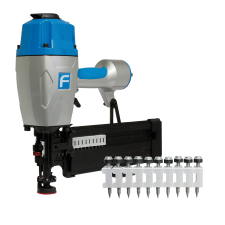
Pneumatic tools are beloved by contractors for their efficiency and ease of use, but those who have not yet worked with them might need some help and guidance. Missteps with these tools can be both costly and painful, so proceed with caution on the first few projects. If you are new to pneumatics, here are five best practices to follow.
Test the Depth of Drive
Most pneumatic tools have an adjustable depth of drive, and depending on the project you may need to tweak the settings. Tools that do not have an adjustable depth of drive feature can be adjusted through other mechanisms such as hose air pressure. In either case, take a few test fires on a scrap piece of wood to ensure the depth is correct. When adjusting, be sure to keep the project materials in mind as well. Dense or hard woods like maple might require higher air pressure to drive properly.
Check the Magazine
When powering through a project, it’s easy to forget to reload the magazine. However, it’s better to reload before the tool has actually run out of fasteners because it may still fire and leave a dimple in the wood. This is because the driver will come forward and slam directly into the wood, which will cause some damage. Additionally, it can damage the tool itself, so make sure you’re checking reload indicators throughout the project to avoid expensive mishaps.
Position Pins Correctly
Although not all pins come with a “this end up” label, many do. Pins do not have a crown or head, and it can be difficult to determine which end is the point. Most manufacturers will include an arrow or another type of symbol that labels the point of the fastener. It’s important to pay attention to this detail because loading pins incorrectly will not allow the fastener to drive completely into the wood. If done repeatedly, the point of the pin can cause damage to the driver, which will make the tool perform less effectively.
Use a Light Touch
The general rule is less is more when it comes to pneumatics. While these tools tend to require a bit of force to depress the nose tip, too much pressure can have some adverse effects on the surrounding wood. Excess pressure will cause the nose to strike the wood twice, which will leave an extra dimple near the fastener site. Some nailers don’t require any force at all, so when in doubt, use a light touch.
Keep Hands Out of Harm’s Way
Many contractors have been scorned by a rogue nail, so keep your fingers out of harm’s way to avoid injury. Fine fasteners have a tendency to follow the wood’s grain, and from time to time the fastener will blow out the side of the joint. Knowing that, keep fingers away from potential off-course paths. To prevent wandering nails, fire them perpendicular to the grain and always wear protective gear like gloves and safety glasses.
Pneumatic tools are not the right fit for every project; but they are safer, more light weight, and oftentimes more affordable than leading alternatives. For someone new to pneumatic tools it’s important to understand what projects these tools are appropriate for, and above all, how to use them safely and effectively. With the above tips, using your new pneumatic will be a breeze. To learn more about the applications of pneumatic tools, download our white paper, “Benefits of Pneumatic vs. Traditional Tools”.
.svg.png)

